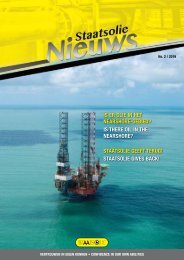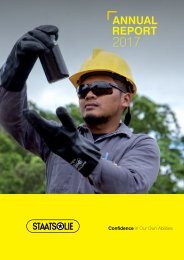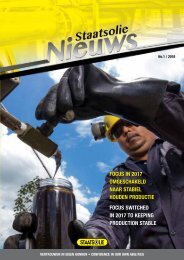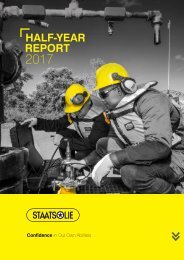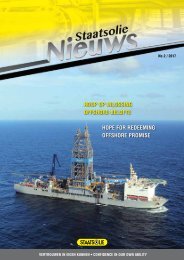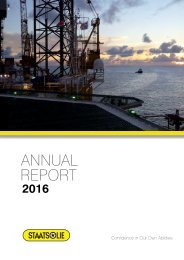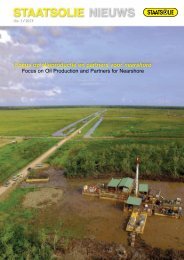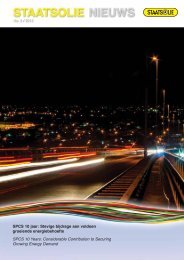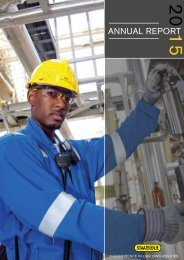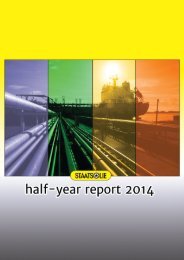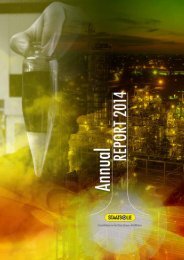Staatsolie Nieuws January 2019
Create successful ePaper yourself
Turn your PDF publications into a flip-book with our unique Google optimized e-Paper software.
UPSTREAM<br />
STALEN PIJPLEIDINGEN<br />
WORDEN GEFASEERD<br />
VERVANGEN<br />
STEEL PIPELINES ARE<br />
GRADUALLY REPLACED<br />
De stalen buizen waarvan de oliepijpleidingen in de productievelden zijn gemaakt, zijn door<br />
de jaren heen gaan roesten door de vloeistoffen en gassen die er doorheen stromen. Daarom<br />
vervangt <strong>Staatsolie</strong> alle stalen buizen door sterke roestvrije kunststofbuizen gemaakt van hoge<br />
dichtheid polyethyleen (HDPE).<br />
Through the years, the steel casing of the oil pipelines in the production fields are showing<br />
rust due to the fluids and gases that pass through them. <strong>Staatsolie</strong> is therefore replacing<br />
all steel casing with strong corrosion-resistant synthetic pipes made of high-density<br />
polyethylene (HDPE).<br />
Er wordt gestadig gewerkt aan<br />
het vervangen van de pijpleidingen.<br />
We are constantly working on<br />
replacing the pipelines.<br />
For now, only the steel casing in the most crucial<br />
parts of the production fields are being replaced.<br />
Eventually, the most important part of the 450<br />
kilometers measuring pipeline system must be<br />
replaced by this more durable material.<br />
Voorlopig worden alleen de stalen buizen in de meest cruciale gebieden in<br />
de productievelden vervangen. Op termijn moet het belangrijkste deel van<br />
het in totaal 450 kilometer lange buizenstelsel zijn vervangen met dit duurzamer<br />
materiaal.<br />
Veel langer<br />
Staal is voordeliger voor de vloeibaarheid van de dikke Saramacca crude omdat het<br />
zonnehitte langer vasthoudt. Hierdoor neemt de stroperigheid af van de olie waardoor<br />
deze makkelijker kan stromen. Stalen buizen beginnen na verloop van tijd te roesten.<br />
“We moesten daarom uitkijken naar materiaal dat veel langer mee gaat”, zegt Kisoorkoemar<br />
Harangi, supervisor Veldproductie van het Tambaredjo-productiegebied. Na<br />
testen met buizen van verschillende materialen, is uiteindelijk besloten om HDPE (highdensity<br />
polyethylene) te gebruiken.<br />
Overigens wordt voor het aanleggen van nieuwe productiebronnen uitsluitend gebruikt<br />
gemaakt van HDPE-buizen. De omtrek varieert voor flowlines (buizen die lopen van de<br />
bron naar de testtanks) tussen 30 en 40 centimeter en voor headers (pijpleidingen die<br />
lopen van testtanks naar de olieverwerkingsinstallaties op TA58 en Jossiekreek) tot 55<br />
centimeter. “Het streven is om in deze fase zeven kilometer aan buizen te vervangen.”<br />
<strong>Staatsolie</strong> <strong>Nieuws</strong> • No. 1 • <strong>2019</strong><br />
Much longer<br />
Steel is more beneficial for the fluidity of the<br />
viscous Saramacca crude, for it retains the heat<br />
of the sun much longer. This causes the viscosity<br />
of the oil to drop, allowing it to flow free. Steel<br />
pipes rust over time. “We therefore had to look<br />
for material that lasts longer”, says Kisoorkoemar<br />
Harangi, supervisor Field Production of the<br />
Tambaredjo operations. “After tests with pipes<br />
made of various materials, we finally decided to<br />
use HDPE (high-density polyethylene).<br />
In addition, HDPE pipes are exclusively used for<br />
constructing new production wells. Their measures<br />
vary for flow lines (pipes that go from well<br />
to test tanks) between 30 and 40 centimeters<br />
and for headers (pipelines that go from test tanks<br />
to treatment facilities at TA58 and Jossiekreek)<br />
to 55 centimeters. “We plan to replace seven<br />
kilometers of pipes in this phase.”<br />
23






